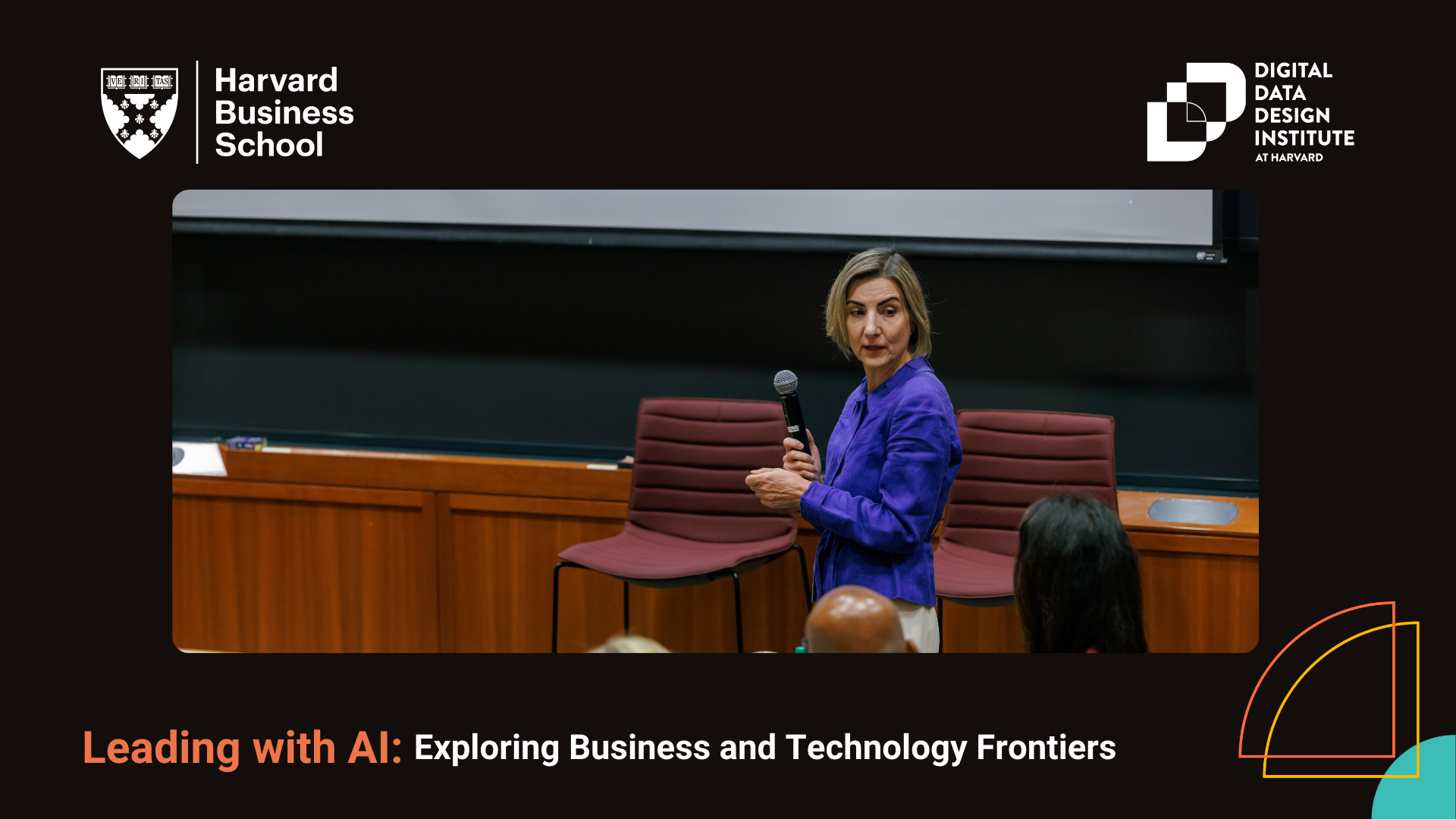On May 7, the Digital Data Design Institute at Harvard hosted Leading with AI: Exploring Business and Technology Frontiers. The conference featured breakout sessions where industry experts discussed specific and specialized topics. The breakout session on “Bridging the Generative AI Leadership Gap” featured two presenters, Charlene Li, CEO of Quantum Networks Group, author, and expert on leadership and disruptive technologies, and Katia Walsh, Chief Digital Officer at Harvard Business School. They discussed how to be a leader in the age of AI, including generative AI concepts and practical applications, and took questions from session participants.
Key Insight: Mastering AI
“How do you actually bridge this gap between knowing, doing, and leading? How do you pull together a strategy, something that tells [you] you’re going to get from here to there in a world that’s constantly changing?”
Charlene Li
Charlene opened the session by polling participants on how many of them are currently using AI, and how often. She used the acronyms FOMO (fear of missing out) and FOGI (fear of getting in) to describe prevailing attitudes toward AI, and some benefits and pitfalls of AI driving these feelings. The first step in becoming a leader in AI is to master AI, which includes three steps:
- Write: Start by using AI to write emails, presentations, and memos. Practice and experiment with “prompt conversations” and the results.
- Research: Ask tools to summarize company research and other materials to develop potential conversations with these companies.
- Experiment: Treat AI as a sounding board or thought partner to share ideas, strategies, and plans, and to get analysis, feedback, and suggestions.
At this stage, you don’t have to have all the answers—simply use generative AI for help. Get good at asking questions, and treat the questions and prompts you develop as intellectual property that you can capture, iterate, and develop best practices around.
Key Insight: Setting in the Strategy
“[T]hese emerging tech-enabled transformations are always in service of the corporate strategy and of the customers of a company.”
Katia Walsh
The discussion transitioned to Katia, who noted that the area of generative AI that is least talked about is strategy. She had these practical tips for leaders who want to begin setting strategy around AI:
- Create a minimum viable team (MVT): Start quickly—don’t overthink the members of this team, for example, get people who can represent the customer, a digital AI executive (if available), and HR.
- Set policies and update them frequently: Begin by setting rules around tool data (for example, do not enter proprietary, confidential, or personal information in any AI tool), privacy and security, and data and customer protection.
- Strive for good AI: Good AI is ethical and responsible, aligns with your company values, and minimizes bias and discrimination. Aim for diversity in your MVT and in the tools you use (for example, open source tools).
- Ensure transparency: Set a code of ethics (like a “Hippocratic Oath”) users must agree to before accessing and using data. Set expectations on the process with employees. Consider whether you should disclose your company’s use of AI to customers.
After setting preliminary ground rules, review and revise them regularly. Like AI technology, your strategy must continue to evolve. Next, begin to develop your strategy:
- Think big: Define the vision. Identify something that doesn’t make sense and ask why.
- Start small: In this context, small means focused—on a goal, problem, opportunity, or priority. Work with your MVT on where to focus for quick wins by considering:
- Size: How much value would a solution deliver?
- Speed: How quickly will you see value?
- Scalability: Will the solution apply beyond one business unit or function?
- Scale fast: To scale your project, focus on the “edges” or limits of AI experimentation. Give employees permission and make them feel safe. Then create a rolling 18-month plan for implementation. A rolling plan enables you to lay out what you plan to do, change, and experiment with; map out your capabilities; and adjust and extend the plan on a quarterly basis.
Key Insight: Sustaining Transformation
“The more you can get the tools into the hands of people, especially at the front lines, they become the leaders of this change, even though they don’t have a title, even though [they’re] just individual contributors.”
Charlene Li
Once you master AI and set a strategy, the challenge becomes sustaining the transformation:
- Create an AI Council to execute the rolling plan. Do not create this team too soon, and provide specific tasks to legal, regulatory, security, and compliance teams to develop a generative AI policy while the rest of the Council executes the plan.
- Train employees, starting with the top two levels of executives who represent the company’s strategic vision. Use either a secure enterprise system “playground” or Team-GPT. Ensure the privacy mode is set to “do not train the model with my content” to protect company information.
- Share what you learn across the enterprise and treat the prompts you develop as intellectual property.
Develop leaders throughout the company to democratize access, which is another way to drive transformation. Articulate your strategy to build trust and avoid misconceptions.
Examples from Industry
Both Charlene and Katia provided examples of companies using AI, including:
- Levi Strauss used AI transformer networks to innovate on new clothing designs.
- Prudential Financial used AI to regain its customer-centricity, with a complete reorganization and digital, data, and machine learning to streamline customer access to information.
- At Vodafone, AI drove personalized customer support to improve its competitive advantage.
- A global call center company implemented AI to increase efficiency and accuracy, and used employees’ additional capacity to develop a new source of revenue as a professional services provider.
- When Southwest Airlines implemented AI, they clearly articulated their values and strategy, and rather than laying off employees, they used the opportunity to change their business.
Conclusion
The session ended with a Q&A period, covering oversight of AI (centralized or decentralized), how to create edges vs. allowing employees to explore, AI education for board members and addressing ROI with executives, characteristics of MVT members, transparency in regulated industries, and managing intellectual property.
Overall, Charlene and Katia emphasized the importance of leaders demonstrating and providing openness, education, and ethics when developing their AI strategies to protect employees, empower customers, and continue to grow and prosper. Many of these concepts and more are covered in their new book, “Winning with Generative AI: The 90-Day Blueprint for Success.”
Meet the Speakers

Charlene Li is an expert and a LinkedIn Top Voice on leadership and disruptive technologies. She is a sought-after keynote speaker, strategic advisor, and executive transformation coach, and the founder and CEO of Quantum Networks Group. Charlene is the “New York Times” bestselling author of six books. She earned her MBA from Harvard Business School and a BA in International Relations and Affairs and an AB in Social Studies from Harvard University.

Katia Walsh, PhD, is Harvard Business School’s inaugural Chief Digital Officer and a member of the School’s executive leadership team after many years as a “transformation warrior” in corporate, board, and academic settings. She holds a PhD from the University of Missouri-Columbia in Strategic Communication with a specialization in quantitative methodology, a Master’s degree in Communication, Journalism, and Related Programs from Sofia University St. Kliment Ohridski (Bulgaria), and a Master of Arts (MA) from The Media School at Indiana University Bloomington.
Additional Resources
Co-authors of “Winning with Generative AI: The 90-Day Blueprint for Success” (book)
- The Big Gulp Newsletter (blog)
- Planning your 2025 strategy? (LinkedIn event)
- The Disruption Mindset: Why Some Organizations Transform While Others Fail (book)
- CIOs Contend With Pushback on AI Rollouts (WSJ article)
- AI and digital transformation shape the consumer experience (Deloitte podcast)
- Q&A with New Chief Digital Officer Katia Walsh (HBS News Story)
